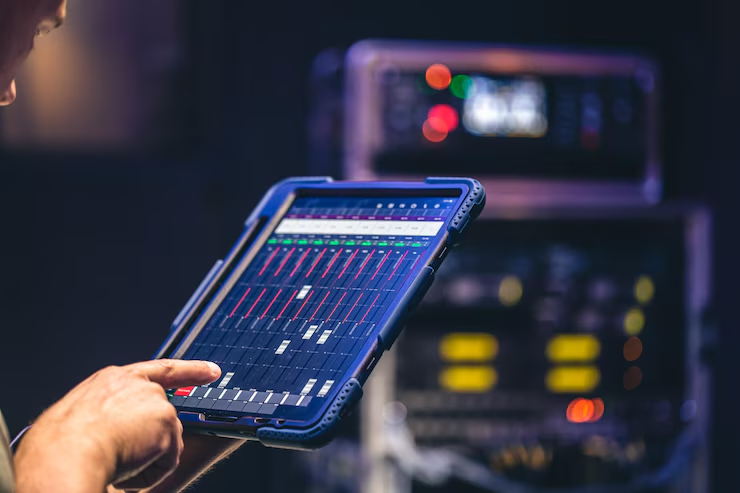Intelligent Healthcare Environments – IoT Solutions for Next-Generation Medical Facilities. The moment I walked into Apollo Hospital’s new smart ward in Hyderabad last month, I knew I was witnessing healthcare’s future. A patient had just shifted slightly in her bed, and before any nurse noticed, the bed had already adjusted itself to prevent pressure ulcers. Meanwhile, a doctor miles away was reviewing her real-time vitals on his tablet. “Three years ago, this would have required five staff members and constant vigilance,” the hospital administrator told me. “Now the system alerts us before problems even develop.”
A Web of Care, Woven with Data
Healthcare is arguably the most human-centered industry that exists which is precisely why the Internet of Medical Things (IoMT) has such transformative potential. Unlike industrial applications where IoT primarily drives efficiency, in healthcare it quite literally saves lives.
The concept sounds deceptively simple: connect medical devices, environmental sensors, wearables, and hospital systems through secure networks that collect, transmit, and analyze data in real time. But the implications are revolutionary.
As Dr. Meena Sharma, Chief Digital Officer at a major Mumbai hospital network, explained to me: “We’re not just digitizing healthcare we’re fundamentally changing how we detect, diagnose, and deliver care. The stethoscope transformed medicine in the 19th century. IoT is our century’s equivalent breakthrough.”
The Invisible Infrastructure of Smart Healthcare
During my tours of several IoT-enabled facilities across India, I discovered that the most powerful implementations are often the least visible. These systems work quietly in the background, creating an intelligent ecosystem that supports medical professionals rather than replacing them.
Patient-Centered Monitoring: Advanced wearables now track far more than just heart rate and steps. A diabetic patient I spoke with showed me her continuous glucose monitor that automatically alerts her physician when patterns suggest potential complications. “It caught my hypoglycemia trend during sleep something even I wouldn’t have noticed until it became dangerous,” she told me.
Environmental Intelligence: At a pediatric ward in Bangalore, IoT sensors monitor everything from room temperature and humidity to noise levels and air quality. The system automatically adjusts HVAC parameters to maintain optimal healing conditions for different patient needs. The technical sophistication is remarkable LoRaWAN sensors operating on ultra-low power transmit environmental data while minimizing electromagnetic interference with critical medical equipment.
Asset and Workflow Optimization: Perhaps the most technically impressive application I witnessed was at a busy emergency department in Delhi. RFID-enabled equipment, from crash carts to portable ultrasounds, are continuously tracked using a mesh network of BLE (Bluetooth Low Energy) beacons. When emergency cases arrive, AI algorithms analyze available resources and patient conditions to suggest optimal treatment room assignments and equipment preparation. The system has reduced critical response times by nearly 40%.
The Technical Backbone
What makes these smart hospitals work is a sophisticated technical infrastructure that most patients never see:
Edge Computing Nodes process critical data locally ensuring that life-supporting systems continue functioning even if network connectivity is interrupted. These edge devices typically run on hardened RTOS (Real-Time Operating Systems) with redundant power systems.
Low-Power Wide Area Networks (LPWAN) create resilient connectivity that can penetrate the challenging environments of hospital buildings concrete walls, lead-lined rooms, and electromagnetic interference from medical equipment.
AI and ML Algorithms continuously analyze data streams, identifying patterns that might escape even experienced medical professionals. These aren’t just simple threshold alerts but sophisticated models that understand context and patient history.
The Human Impact
Beyond the technical marvels, what truly matters is how these systems affect patient outcomes. During my visit to a cardiac care unit in Chennai, a cardiologist shared a poignant story: “Last year, our predictive algorithm detected subtle changes in a patient’s vital signs pattern nothing that would trigger traditional alarms, but the AI recognized it as a precursor to cardiac distress. We intervened 30 minutes before the patient would have experienced a major event. That’s the difference between prevention and emergency.”
Challenges at the Intersection of Tech and Care
Despite its promise, healthcare IoT faces unique challenges. During a roundtable with hospital CIOs, several common concerns emerged:
Security and Privacy: Medical data is among the most sensitive information, requiring end-to-end encryption and rigorous access controls.
Interoperability: Devices from different manufacturers must communicate seamlessly a challenge being addressed through standards like HL7 FHIR and IEEE 11073.
Clinical Validation: New IoT solutions require evidence that they improve outcomes, not just processes.
The Path Forward
As IoT continues transforming healthcare facilities, we’re moving from fragmented point solutions to comprehensive smart hospital ecosystems. The pioneers I’ve met across India’s healthcare landscape share a common vision- facilities that feel more human precisely because technology handles the routine, allowing medical professionals to focus on what technology cannot replace human connection, complex judgment, and compassionate care.
In the words of a nurse, I interviewed- “The technology doesn’t replace our expertise it amplifies it. Our smart hospital doesn’t feel cold or robotic. It feels more responsive to human needs than traditional hospitals ever could.”
That, perhaps, is the greatest promise of healthcare IoT technology that becomes invisible while making the human elements of care more visible than ever.
Conclusion: The Intelligent Pulse of Modern Healthcare
As we look toward the future of healthcare delivery, IoT will increasingly serve as the intelligent pulse monitoring the health of not just patients, but entire medical facilities. The transformation is more than technical it’s philosophical. Smart hospitals aren’t just about sensors and networks; they represent a fundamental shift from reactive to proactive care, from isolated interventions to connected ecosystems, from standard protocols to personalized medicine.
For healthcare leaders navigating this transformation, the message is clear technology implemented thoughtfully doesn’t dehumanize healthcare it creates space for more humanity at the moments when it matters most. As India’s healthcare system continues embracing these innovations, we’re not just building smarter facilities we’re reimagining what compassionate, effective care can become in the digital age.

